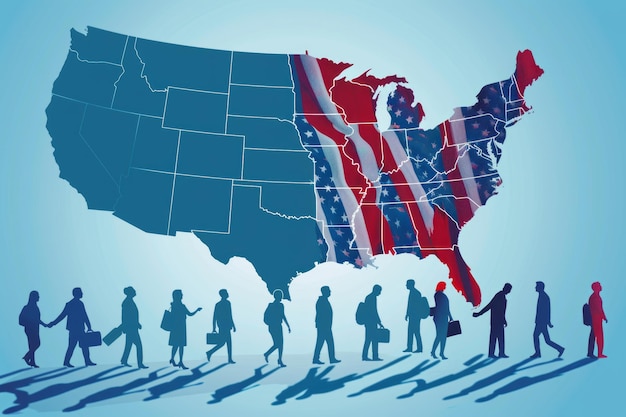Electoral College 2025: Understanding the US Presidential Election

Understanding the Electoral College is crucial for every US citizen to grasp how the US President is elected; this guide explains the process, its importance in 2025, and its impact on American democracy.
The **Understanding the Electoral College: A 2025 Guide to How the US President is Elected** is not merely an academic exercise; it is a vital component of informed citizenship. Millions of Americans head to the polls every four years. But do you know what happens after you vote?
What is the Electoral College?
The Electoral College is a constitutionally mandated process, not a place or a building, by which the United States elects its president and vice president. Instead of directly voting for a candidate, citizens vote for a slate of electors who then cast the actual votes for president. Let’s explore the fundamentals of how it operates.
The Basics Explained
Each state is allocated a number of electors equal to its total number of representatives in Congress (House + Senate). For instance, California, being the most populous state, has a substantial number of electors, while smaller states like Wyoming have fewer.
The current system is largely based on the “winner-take-all” approach, where the candidate who wins the popular vote in a state typically receives all of that state’s electoral votes. This system, while seemingly straightforward, can lead to scenarios where the popular vote winner does not become president.
- The Electoral College was established by the Founding Fathers as a compromise between election of the President by a vote in Congress and election of the President by a popular vote of qualified citizens.
- The number of electors each state gets is equal to its total number of Senators (always two) and Representatives (based on population).
- All states except Maine and Nebraska use a winner-take-all system.
Understanding the Electoral College involves grasping the historical context, constitutional underpinnings, and the practical implications of its operation. Keep reading to understand how it works and why this process exists.

Why Does the Electoral College Exist?
The Electoral College emerged as a compromise during the Constitutional Convention of 1787. The Founding Fathers grappled with how to balance the power of the population centers with that of the less populous states. Its origins were rooted in profound debates about democracy, representation, and federalism.
The Compromise of 1787
The Electoral College was not initially conceived as it functions today. The primary aim was to create a buffer between the population and the selection of a President, while also giving states a role. The process sought to prevent potential tyranny of the majority and ensure that all states, regardless of population, had a voice in the election.
Some of the Founding Fathers feared pure democracy, where direct popular vote would decide the election; others were wary of giving too much power to Congress. The Electoral College seemed to be the ideal solution.
- Protection Against Tyranny of the Majority
- Compromise Between Large and Small States
- A Check on Direct Democracy
Without the Electoral College, presidential candidates would likely focus almost exclusively on densely populated areas, ignoring the interests and concerns of smaller states. This would lead to imbalanced policies and a potentially fractured union.

How the Electoral College Works in 2025
In presidential election years, understanding the Electoral College process is essential to knowing how votes translate into power. Here’s a step-by-step breakdown of how the system works in contemporary US elections.
Step-by-Step Process
The Electoral College process starts with the popular vote in each state during the general election. On Election Day, citizens cast their ballots for a presidential candidate. In almost all states, the candidate who receives the most votes wins all of that state’s electoral votes. Maine and Nebraska use a district system to allocate electoral votes.
The electors then meet in their respective states in December to cast their votes. These votes are sent to Congress, where they are counted in January. Assuming all goes smoothly, the candidate with at least 270 electoral votes is declared the winner.
- Popular Vote: Citizens cast ballots for their preferred candidate.
- Electoral Vote Allocation: Most states use the winner-take-all system.
- Electoral Vote Casting: Electors meet to cast their votes.
- Congressional Count: Votes are counted, and a winner is declared.
Some states have laws requiring their electors to vote for the candidate who won the popular vote in their state; these are known as “faithless electors.” Although faithless electors are rare, they generate occasional controversy. Understanding the process means knowing the nuances of these systems.
Swing States and the Electoral College
Certain states, known as “swing states” or “battleground states,” play an outsized role in presidential elections due to their competitive nature. These states have a history of voting for candidates from both major parties and are often the focus of intense campaigning.
The Impact of Swing States
Swing states such as Pennsylvania, Florida, and Ohio can significantly influence election outcomes, and it’s crucial to understanding the Electoral College’s modern dynamics. Candidates devote substantial resources to winning these states, as victory here can determine which candidate reaches the 270 electoral vote threshold.
The winner-take-all system underscores the importance of swing states. Even a narrow victory in these states can deliver all their electoral votes to a candidate, highlighting why they are persistently targeted.
Key swing states in recent elections include:
- Pennsylvania
- Florida
- Ohio
- Wisconsin
Campaign strategies are often tailored to appeal to the specific demographics and issues prevalent in swing states. These can include economic concerns, social issues, and regional interests. Understanding these targeted appeals is vital when following closely contested elections.
Criticisms and Defenses of the Electoral College
The Electoral College has been both praised and criticized since its inception. Many defend it as a safeguard for the interests of smaller states, while others argue it undermines the principle of one person, one vote.
Arguments For and Against
Proponents of the Electoral College maintain that it protects the interests of rural voters and prevents a “tyranny of the majority.” They also suggest that it promotes national unity by requiring candidates to build broad coalitions across different regions and demographics.
Critics, on the other hand, argue that the Electoral College can lead to situations where the popular vote winner does not become president, undermining the democratic principle of majority rule. It can also depress voter turnout in states where the outcome is perceived as predetermined.
Arguments often made about the system include:
- Pro: Protects rural voters.
- Pro: Promotes national unity.
- Con: Undermines majority rule.
- Con: Depresses voter turnout.
The debate over the Electoral College is likely to continue as long as the system remains in place. Understanding both sides of the argument is essential for engaging in informed political discussion and advocating for potential reforms.
Potential Reforms to the Electoral College
Over the years, several proposals have been put forth to reform or even abolish the Electoral College, aiming to address the perceived shortcomings and enhance the democratic nature of presidential elections. Despite numerous debates, these proposals face considerable obstacles and require substantial political will.
Proposed Changes
One common proposal is the National Popular Vote Interstate Compact (NPVIC), an agreement among states to award their electoral votes to the candidate who wins the national popular vote. The compact would take effect once states representing at least 270 electoral votes join the agreement.
Another approach is a constitutional amendment to abolish the Electoral College and implement a direct popular vote. However, this would require the support of two-thirds of both houses of Congress and ratification by three-quarters of the states, making it a difficult endeavor.
Here are some reform ideas:
- National Popular Vote Interstate Compact (NPVIC)
- Constitutional Amendment for Direct Popular Vote
- Proportional Allocation of Electoral Votes
Reforming the Electoral College is a complex issue with deep constitutional and political implications. Any significant change would likely reshape the dynamics of presidential elections and alter the balance of power between states.
| Key Concept | Brief Description |
|---|---|
| 🗳️ Electoral Votes | Each state gets votes based on its congressional representation. |
| ⚖️ Winner-Take-All | The candidate winning the popular vote in a state usually gets all its electoral votes. |
| 📍 Swing States | States with competitive races that heavily influence election outcomes. |
| 📜 Compromise | This was a compromise among the founding fathers |
Frequently Asked Questions
▼
The Electoral College is the process by which the United States elects its president and vice president. Instead of directly voting for a candidate, citizens vote for a slate of electors, who then cast the actual votes.
▼
Each state is allocated a number of electors equal to its total number of representatives in Congress (House + Senate). For example, California, being the most populous state, has a substantial number of electors.
▼
The winner-take-all system is used by most states and means that the candidate who wins the popular vote in that state receives all of its electoral votes. This system can lead to situations where the popular vote winner loses the election.
▼
Swing states, or battleground states, are those where the outcome of the election is uncertain, and candidates from both major parties have a chance of winning. They get more attention during the race because they can determine elections.
▼
Some reforms include a direct popular vote. However, this would require a constitutional amendment, which is very difficult to achieve. There is also the National Popular Vote Interstate Compact (NPVIC).
Conclusion
Understanding the Electoral College remains vital for every US citizen preparing for the 2025 elections. By grasping its origins, operations, and potential reforms, you can become an informed and engaged participant in American democracy and better understand the crucial decisions that lie ahead. The **Understanding the Electoral College: A 2025 Guide to How the US President is Elected** will serve as base as we move into the election season.
